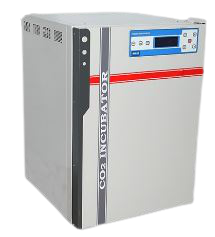REFRIGERATED CENTRIFUGE
MAKE DINESH SCIENTIFIC
DESCRIPTION
With the use of centrifugal force, materials with varying densities can be separated in a sophisticated laboratory device called a chilled centrifuge. It works on the idea that the denser particles in a sample travel outward and form different layers when it is spun rapidly. The following is a thorough explanation of a chilled centrifuge:
A sophisticated laboratory tool called a chilled centrifuge is used to separate particles according to their density from a liquid mixture. Centrifugal force is utilized by this apparatus to quickly spin samples in a temperature-controlled setting, usually between sub-ambient and room temperature.
FEATURES:
- Benchtop Refrigerated Centrifuge:
- Robust C.R.C. structure with powder-coated finish
- A centrifugal bowl made of stainless steel for added protection and simple cleaning.
- Equipped with an electronic drive and a well-balanced brushless motor.
- 20 characters in 4 lines. LCD display for rpm, CF, set and run times, and set times
- There is an automated dynamic brake and an imbalance detector.
MAIN COMPONENTS:
- ROTOR: The sample tubes or containers are held in place by the centrifuge’s rotor. It creates centrifugal force by spinning quickly.
- MOTOR: The rotor is driven by a strong motor, which enables high rotation rates
- CONTROL PANEL: Users can adjust centrifuge process parameters like speed, temperature, and duration via the control panel.
REFRIGERATION SYSTEM:
- This feature separates a conventional centrifuge from a chilled one. It has a cooling system that keeps the centrifugation temperature low, which is essential for protecting the integrity of samples that are sensitive to temperature changes.
FUNCTIONALITY:
- Centrifuge: The main purpose is to rotate the samples quickly such that the denser components settle to the bottom of the tubes.
- REFRIGERATION: The centrifuge’s internal temperature is regulated by an integrated refrigeration system, which permits sample separation without jeopardizing the integrity of materials that are sensitive to temperature changes.
TEMPERATURE CONTROL:
- Depending on the model, the refrigeration system can normally regulate the temperature between below ambient and below zero.
SAFETY FEATURES:
- LID LOCKING MECHANISM: Makes sure the centrifuge lid stays firmly closed while it is in use.
- Automatic Imbalance Detection: In the event of an imbalance, stop the centrifuge to protect the samples and the device.
Capacity and Speed:
- Sample capacity: To handle a variety of sample sizes and kinds, refrigerated centrifuges are available in a range of sizes and rotor designs.
- SPEED CONTROL: Users can adjust the centrifugation settings for various applications using variable speed control.
TECHNICAL DETAILS:
Model: DS-RC-SAR
- Refrigerated multipurpose benchtop centrifuge, 3 liter capacity.
- It will be capable of using fixed-angle and swing-out rotors with an adapter to use different tube formats.
- It will maintain temperature range -9°C to 40°C
- It will have Capacity of 4 x 750 ml bottles and 4 x 4 MTP
- Speed for fixed-angle rotors will be 14,000 rpm and RCF 20,913 x g force; for swing-out rotors, speed is 4,500 x g force.
- It will be a user-friendly operation; key panel with provision to set speed RPM/RCF and radius correction values that can be changed during centrifugation.
- It will have a fast temperature function for rapid cooling of centrifuge and standby cooling options
- It will be an in-built condensate drain to prevent water accumulation
- It will be excellent temperature control with compressor running continuously during the run time
- It will have an automatic shut-off function to reduce energy consumption and extend compressor life when not in use for long hours.
- It will be equipped with automatic rotor recognition and imbalance detection for operational safety.
- Timer setting 1 min to 99 min, with continuous run function and separate short spin key with selectable rotational speed
- It will be able to start the timer count only when the set centrifugation RPM is reached to support the short spin protocols
- It will be 10 acceleration and deceleration steps.
- Noise level at max speed will be 59 dB (A) for quiet operation in the workplace.
- Rotors and rotor lids will be made of metallic and will be fully autoclavable.
- Centrifuge lid with soft-touch lid closure and low opening height for stress-free lid locking.
- It will be the smallest possible foot print and smallest lid opening height for easy sample access while loading and unloading samples
- It will be LCD display
- It will be emergency lid release, preferably on front side (in case of power failure)
Following rotors will come with the instrument:
- Swing out rotor of capacity 4x 250 ml (4,000 rpm; 3200 x g) to accommodate 36 x 15 ml / 16 x 50 ml conical tubes through suitable adaptors. Suitable adaptors will be provided to accommodate 15-mL, 50-mL, and 250-mL tubes / flasks.
- Fixed angle Rotor, aerosol-tight 6 x 50 ml capacity to accommodate 6×15/50 ml conical tubes through suitable adaptors (12,000 rpm; 20,000 x g). The rotor and lid will be metallic & fully autoclavable. Suitable adaptors will be provided to accommodate 15 mL and 50 mL tubes and flasks.
















Reviews
There are no reviews yet.